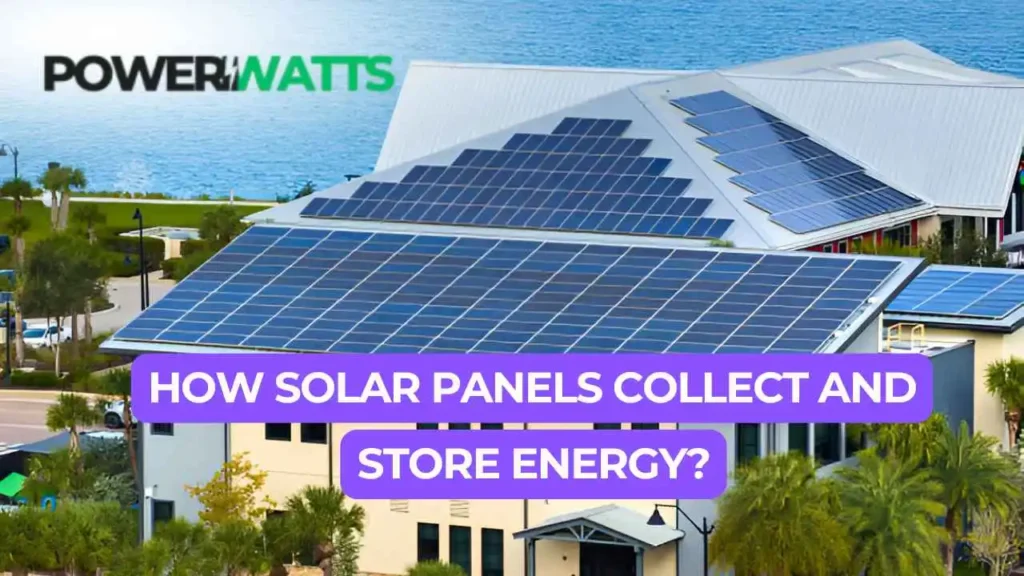Solar panels use the photovoltaic effect to generate power. Silicon-based photovoltaic (PV) cells create DC power when exposed to sunshine. Photons from sunlight activate electrons in the cells’ semiconductor substance, creating an electric current.
Solar energy production is intermittent and weather-dependent, happening only during daylight hours. Energy storage technologies are needed to fix this. Most households store extra solar energy in batteries for use at night or during overcast weather. Popular lithium-ion and lead-acid batteries have pros and cons.
In the article, we will explain how solar panels collect and store energy because it is essential for optimizing solar system advantages and assuring power availability when required. This combined method boosts solar energy efficiency and dependability.
Advantages of Solar Energy Storage
Increased Energy Independence
By saving solar energy, people can depend less on the power grid which makes them more energy-independent. This is especially helpful when the power goes out or when demand is high and prices may be higher for electricity.
Savings on costs
Effects on the Environment
Because it cuts down on the use of fossil fuels, storing solar energy helps lower carbon pollution. It is less important to use nonrenewable energy sources when more sun energy is saved and used.
How Solar Panels Collect Energy And Storage Solutions
The photovoltaic effect is what solar panels use to turn sunlight into power. When sunlight hits the PV cells, it makes electrons in the semiconductor material move around, which makes an electric current. This method works well, and solar panels can still make power on cloudy days, though the output may be lower.
Components of a Solar Panel System
A standard solar panel setup is made up of a few main parts:
- Solar panels are the main parts that take in sunshine and turn it into power.
- An inverter changes the direct current (DC) electricity that the solar panels make into alternating current (AC) energy that homes and businesses use.
- Energy Storage: Extra power is stored for later use in batteries or other storage systems that are built in.
Energy Storage Solutions
Battery Storage
Putting sun energy away most of the time means using special batteries for Solar Light. Lithium-ion batteries are very common because they hold a lot of energy, last a long time, and work well. When solar panels make more electricity than is needed, the batteries store the extra power. The saved energy in the batteries can be used to power the house when the sun isn’t shining, like at night or when it’s cloudy outside.
Thermal Energy Storage
Thermal energy storage systems store the extra heat that solar energy makes so that it can be used later. This is usually done with things that keep heat in, like water or liquid salts, until they are needed for heating or making power. Thermal storage is very helpful in solar power plants that are big.
Mechanical Energy Storage
- Mechanical storage devices turn extra electricity into mechanical energy that can be saved for later use. Some common ways are:
- Pumped hydro storage: When demand is low, water is pumped to a higher level and then released to make energy when demand is high.
- When you have extra energy, you can use it to spin a generator, which can then make power when you need it.
Future Trends in Solar Energy Storage
- New developments in battery technology: As battery technology keeps getting better then the future of storing solar energy looks bright. New developments in solid-state batteries and other new technologies promise to make things safer, cheaper, and more energy-dense.
- Smart energy management systems: In solar setups, smart energy control tools are becoming more and more common. These systems make the best use of energy by keeping an eye on how it is used and deciding automatically when to draw power from the grid or solar storage.
Conclusion
Solar energy for your house decreases your carbon impact and delivers stable electricity. By installing efficient storage systems then you may utilize solar energy at night or on overcast days. Homeowners may optimize solar energy advantages and save money on energy costs using advanced battery technology, including lithium-ion choices.
As demand for alternative energy options rises, solar energy’s future appears bright. A solar energy system with strong storage puts you at the forefront of the clean energy revolution.
Contact us for a customized quote to learn more about solar energy.
Investing in solar energy is not just about saving money; it’s about investing in a cleaner, healthier planet for future generations. Contact us to see how we can help you smoothly switch to solar energy.
FAQs
How Much Does a Solar Energy System Cost?
Solar energy system costs depend on size, location, and subsidies. Residential solar systems cost $12,000–$22,000, including installation. However, many homeowners save enough on their electricity expenses to cover the initial outlay.
Can I Add Batteries to My Existing Solar Power System?
Battery systems may be added to solar power systems. This lets homes store daytime energy for nighttime or power outage usage, improving energy independence and dependability.
Can Solar Panels Work at Night or in the Clouds?
Solar panels may produce power on foggy days, although production will decrease. Without a battery storage device, they cannot generate power at night.
What Happens to Solar Panels in Severe Weather?
Solar panels are hail- and snow-resistant. Most panels can withstand hail. Due to its slant, snow rolls off panels, but if it accumulates, it might impede energy output.
How Do I Maintain Solar Panels?
Solar panels are low-maintenance. Made of sturdy materials, they seldom require cleaning. They should be checked for debris and damage occasionally. Most manufacturers provide performance and defect warranties.
Can I Sell Excess Electricity Back to the Grid?
Yes, many utilities enable households to sell surplus solar power to the grid via net metering. Solar power you create beyond your use might be credited to your energy bill.


